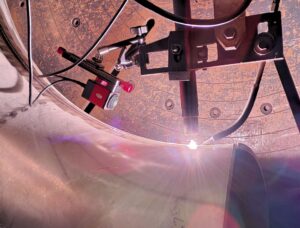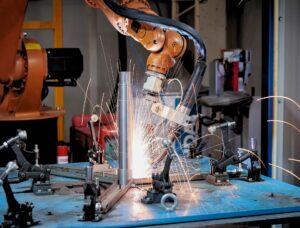Submerged Arc Welding (SAW) is known for its ability to deliver deep weld penetration, high deposition rates, and exceptional weld quality. It’s widely used in industries such as shipbuilding, heavy fabrication, and pressure vessel manufacturing, where thick materials and high-strength welds are essential. However, despite its advantages, SAW presents unique challenges for weld monitoring—especially when it comes to visual inspection. Traditionally, the flux used in SAW covers the weld pool, making it difficult for welders and inspectors to see the weld and the arc in action. This begs the question: Can welding cameras be used in submerged arc welding? Let’s explore how welding cameras can work in Submerged Arc Welding (SAW) and how they help improve quality control and productivity.
1. Overcoming Visibility Challenges with Special Camera Technology
In submerged arc welding, the flux or slag typically covers the welding area, blocking direct visual access to the weld pool and arc. However, modern welding camera systems are designed to handle these challenges. Specialized cameras, including infrared welding cameras and high-resolution arc monitoring cameras, can work through or around the flux and provide visibility of the weld area.
Benefits:
- Monitor the arc without direct line of sight using infrared or specialized cameras for welding
- Capture high-quality images of the weld pool and heat distribution even in challenging conditions
- Use thermal and visual feedback to ensure proper weld quality
2. Enhanced Weld Quality Control in SAW
One of the primary advantages of using welding cameras in submerged arc welding (SAW) is the ability to monitor the weld quality in real time. With traditional SAW, it’s difficult to assess bead consistency, penetration, or any potential defects such as slag inclusions or porosity during the welding process. Welding cameras eliminate this limitation by providing immediate visual feedback.
How It Helps:
- Use weld monitoring systems to track the uniformity of the weld bead
- Detect potential defects like slag inclusion or porosity early in the welding process
- Ensure consistent weld quality, even for complex, high-strength applications
3. Real-Time Adjustments for Better Process Control
The ability to monitor the welding process in real time allows welders to make immediate adjustments to parameters like heat input, arc length, and travel speed. This is particularly important in submerged arc welding, where precision is critical for achieving deep penetration without compromising the material’s integrity.
Efficiency Gains:
- Optimize MIG and MAG welding process for better control in SAW applications
- Prevent over-penetration or incomplete fusion by adjusting welding settings based on camera feedback
- Maintain consistent welding parameters, even with large, thick materials
4. Improved Safety in High-Risk Welding Environments
SAW typically involves high temperatures, heavy equipment, and large workpieces, creating a potentially hazardous environment. By using welding cameras to monitor the welding process remotely, operators can maintain a safe distance from the arc and heat source. This reduces exposure to harmful UV radiation, heat, and welding fumes.
Safety Benefits:
- Minimize direct exposure to intense light and heat by using remote monitoring
- Ensure welders are working in safe conditions, especially when working in confined or elevated spaces
- Use welding camera systems to avoid the need for manual inspection in high-risk zones
5. Automated Monitoring for Consistency in High-Volume Applications
In high-volume submerged arc welding operations, such as those in shipbuilding or heavy industrial manufacturing, maintaining consistency across large quantities of welded components is essential. Welding cameras integrate easily with automated welding systems, providing continuous monitoring and enabling quick adjustments to ensure every weld meets strict quality standards.
Automation and Integration:
- Incorporate robotic welding or automated welding systems for seamless monitoring
- Track real-time feedback with weld monitoring cameras to optimize weld quality across shifts
- Use data from camera systems to create consistent quality control processes in large-scale operations
6. Post-Weld Inspection and Quality Assurance
Even though welding cameras are mainly used during the welding process, they also play a significant role in post-weld inspection. The visual data captured during welding can be reviewed after the fact to ensure the quality of the weld and to verify that all welding parameters were within the required range.
Post-Weld Benefits:
- Record arc welding images for post-weld inspection
- Document weld conditions for compliance and audit purposes
- Analyze video logs for continuous improvement of welding procedures
How Weld Monitoring Systems Help Prevent Welding Distortion
A weld monitoring system plays a crucial role in preventing welding distortion by offering:
- Real-time Arc Welding Image Analysis – Monitors metal movement and temperature distribution.
- Welding Visual Inspection – Detects misalignment and ensures weld quality.
- Process Optimization – Helps adjust heat input, travel speed, and sequence for minimal distortion.
Using a welding camera manufacturer’s system helps improve precision and minimize rework.
Conclusion: Achieve Precision with Proper Distortion Control
While submerged arc welding presents unique challenges due to the flux coverage and heat intensity, welding cameras are proving to be highly effective in overcoming these obstacles. By offering real-time visibility, enhanced quality control, and improved safety, welding cameras provide a level of insight that was once unimaginable in SAW applications.
Whether you’re working in heavy fabrication, shipbuilding, or pressure vessel manufacturing, integrating welding cameras into your submerged arc welding processes can dramatically improve the consistency, quality, and safety of your welds.
Mecaweld offers cutting-edge welding camera solutions designed to meet the challenges of SAW and other welding methods. Want to take your welding operations to the next level? Contact us today to learn how our weld monitoring systems can help you achieve higher-quality welds and greater efficiency.



